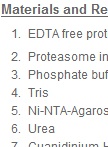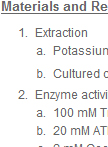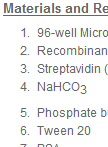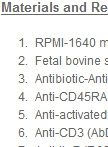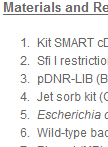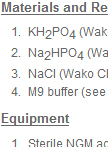Improve Research Reproducibility A Bio-protocol resource
- Protocols
- Articles and Issues
- About
- Become a Reviewer
Past Issue in 2012
Volume: 2, Issue: 17
Biochemistry
Purification of His-ubiquitin Proteins from Mammalian Cells
This protocol is used to purify His-tag ubiquitin conjugated protein. In this particular case, cells were transfected with His-tag ubiquitin and p53 which allowed us to purify using His-tag and reveal the WB using antibodies against p53 to see just the p53-ubiquitinate. The present protocol can be used in general for His-tag proteins expressed in mammalian cells.
Acetyl-coenzyme A Synthetase (Acs) Assay
Acetyl-coenzyme A synthethase (Acs, E.C.6.2.1.1) is an acetate activating enzyme widely represented in nature from bacteria to human. Its function is important for cellular catabolism, especially in order to support microbial growth at low concentrations of acetate (et al., 2011; Castano Cerezo et al., 2009;Renilla et al., 2012). In this protocol, a continuous coupled enzymatic assay for Acs activity is described. Product formation is followed spectrophotometrically by the formation of NADH. The protocol is tailored for E. coli’s Acs, but it can be adapted to assay Acs in any other organism.The acetyl-coenzyme A synthetase (Acs) assay was first described by Brown et al. (1977). Acs activity is measured using an enzymatic method coupled to malate dehydrogenase (Mdh) and citrate synthase (Cs):(Acs) acetate + CoASH + ATP -> acetyl-CoA + AMP(Cs) acetyl-CoA + oxaloacetate -> citrate + CoASH(Mdh) L-malate + NAD+ -> oxaloacetate + NADHNet reaction: Acetate + ATP + L-malate + NAD+ -> citrate + AMP + NADHUnder the assay conditions, Mdh and Cs activities are in excess and the rate of NADH formation is limited by Acs activity.
Protein-RNA ELISA Assay
Protein-RNA ELISA assay is an effective and quantitative method to study protein-RNA interactions in vitro. In this protocol we used recombinant 6x HIS tagged protein, but it works as well for non tagged proteins.
Immunology
Ex vivo Co-culture of Lymphoid Tissue Stromal Cells and T Cells
Stromal cells within lymphoid tissues produce IL-7, which is critical for the survival and function of T cells. This protocol is to be used to isolate primary human lymphoid tissue stromal cells to study their impact on the survival of T cells in an ex vivo co-culture system.
Microbiology
Polyadenylated RNA Sampling
Polyadenylation is a post-transcriptional modification of RNA occurring in prokaryotes, eukaryotes and organelles. However, the function and extent of bacterial polyadenylation are in marked contrast to those of eukaryotic poly(A) tails. In fact, the long poly(A) tails of eukaryotic mRNAs play an important role in their exportation to the cytoplasm and promote mRNA stability and translation, whereas the short bacterial tails facilitate RNA decay. One of the obstacles encountered by investigators studying bacterial polyadenylation is the scarcity of polyadenylated RNAs. The method described here allows reverse transcription and PCR amplification of the whole population of polyadenylated RNAs provided that the poly(A) tails are long enough to hybridize to oligo dT30 sequence. To this end utilization of exoribonucleases deficient strains may be useful.
Neuroscience
The Method of the Body Bending Assay Using Caenorhabditis elegans
This protocol is useful to obtain clear and repeatable data to know the motor function of a worm by counting the number of body thrash in M9 buffer. The thrashing assay is useful for observation of the effect of loss of motor neurons such as VA or VB neuron.


